“… Because its purpose is to create a customer, the business has two — and only two — functions … Marketing and Innovation. Marketing and innovation produce results, all the rest are costs …” — Peter Drucker
The Importance of Innovation
The creativity and inventiveness of people are vital ingredients for any business. However, it is only through innovation, implementation, and exploitation of their ideas that a business is able to compete and prosper.
Already, the competitive landscape has significantly changed with globalisation. Now appearing are many new competitors from low-wage, dynamic economies. For instance, China has given birth to some 100 automakers, with names like Geely, Chery, Great Wall Motors, and Brilliance. Who knows which of these fledgling car companies will become the global giants of the future?
Staying competitive will require a step change in innovation performance. And so it is time for businesses to start innovating their approach towards innovation.
As Peter Drucker points out, the two key activities within any business are Marketing and Innovation. Marketing allows the identification and understanding of suitable hungry markets. Innovation allows the fulfillment of the market’s needs in some unique way that is difficult for competitors to copy. Without marketing, there is no customer pull. Without innovation, your proposition is copied, prices tumble and then there is no profit.
Innovation Failure
Everyone knows that innovation brings rewards but it also brings risks and high rates of failure. Every innovation starts with an invention, something unique or original that will set you apart from your competitors.
Accurate figures are hard to come by, but according to Nesta [1], the invention statistics look something like this:-
- Only 1 in 100 inventions cover their costs
- Only 1 in 300 inventions make a significant difference
- Only 1 in 1400 inventions is a world beater
Even successful invention brings risks in either the form of speedy imitators or litigation due to infringement of other people’s intellectual property. Often the best and most radical ideas pose the greatest challenge for any business – generally, people do not like change!
“There is nothing more difficult to take in hand, more perilous to conduct, or more uncertain in its success, than to take the lead in the introduction of a new order of things, because the innovator has for enemies all those who have done well under the old conditions, and lukewarm defenders in those who may do well under the new.”
Niccolo Machiavelli, The Prince (1532)
Or more simply stated by one of the pioneers of the computer industry:
“Don’t worry about people stealing your ideas. If your ideas are any good you’ll have to ram them down people’s throats.”
Howard Aitken
However, the biggest cause of failure is poor implementation, in particular, the process of turning an idea into a successful innovation. If we look at implementation at three levels: choosing where to add value, creating value and capturing value, then common issues raised are:
Choosing Value
“We can’t agree where we are going and so we back too many opportunities”
“Every time we start on something, we change our mind”
“There’s no point in suggesting ideas because nobody is interested”
“We thought it was right but there was no profit because our competitors were just giving it away”
Creating Value
“We always get to market too late”
“Our development costs just seem to keep spiraling upwards”
“Everything seems to be going well and then there’s always a nasty surprise towards the end”
“We have the right skills, but they are never available on time”
“We ought to forget our estimates because they have no bearing on the eventual costs and timing”
“We never seem to get round to doing anything new”
Capturing Value
“The customer only seems interested in cost and not the value of our offer”
“Our probability of bid winning is too low”
“The customer seemed to recognise the value of our offer, but still went elsewhere for the goods”
With all these issues you may wonder whether innovation is worth it. It’s no wonder that many companies buy innovations from smaller companies – once proven!
And yet, according to Henry Chesbrough, author of Open Innovation [2], although most innovations fail –
“Companies that don’t innovate die.”
In today’s world, where change is constant, competitors are numerous and hungry nations are capturing routine jobs at much less cost – then better innovation management is vital for all companies big and small.
Better Innovation Management
Many of these failings are preventable by the sensible introduction of innovation-oriented leadership, excellent management practices, and tools.
The table below shows some of the measures that lead to better innovation:
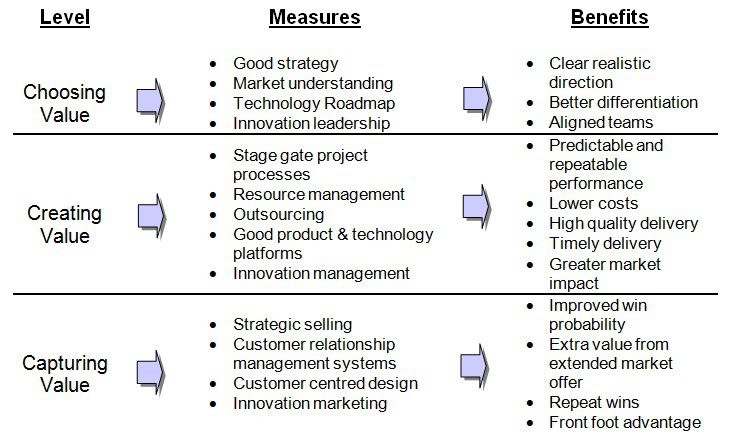
It is beyond the scope of this guide to discuss all of these measures, but the two measures that have the greatest impact are innovation-oriented leadership and stage-gate project processes.
Clearly, innovation-oriented leadership not only prioritises innovation but also:
- Creates a culture that supports innovation
- Ensures buy-in and ownership from business unit managers
- Ensures effective cross-functional teamwork
- Communicates company strategy and creates the necessity for invention
- Ensures the right level of training and coaching
- Provides total participation for idea generation
Whereas stage gate project processes:
- Helps justify & secure sufficient resources for innovation execution
- Resolves project fuzzy front-ends
- Ensure cross-functional participation during target setting and risk identification
- Develops the right criteria and metrics in advance
- Provides appropriate monitoring and control
- Drives the quest for ideas
What is the stage-gate development process
Stage gate or phase review is a popular development process for risk managing technology type projects [3,4]. Key to the process are regular stage gates or phase reviews where projects are passed, canceled, or re-directed according to their progress against given targets. The phases do overlap, this is called simultaneous engineering. However, the phase exits are sequentially ordered.

It is notoriously hard to cancel projects early due to the association with failure. However, stage-gate embraces project failure, by recognising the fact that it is better to understand the points of failure early so that project resources can be freed for more promising developments, rather than find the show stopper late in the development process once all the money has been spent.
Therefore, the project pipeline is managed like a funnel with many ideas going in and with early culling where the ideas lack promise. Resources can then be focussed on the few projects that have the potential to become commercial successes.
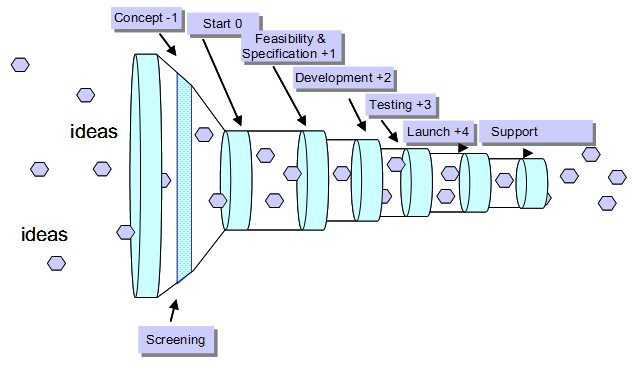
An important aspect of the stage gate is the cross-functional nature of innovation. Therefore, the phase reviews are usually carried out by a review body with representatives from all the relevant functions.
Furthermore, reviews do not screen projects purely on the basis of business hurdles but also because projects compete with each other and so it is important to have plenty of ideas going into the funnel.
Innovation always presents an element of risk due to the fact that you are doing something new. Therefore, a stage gate is ideally suited to innovation projects where risky ideas are actively sought because they can always be culled early if the risks cannot be successfully resolved. However, if the risks are resolved then this leads to big increases in project earned value and much potential for intellectual property protection and competitive advantage.
This report now gives a general overview of the stage-gate phases for a typical new product programme. However, the processes should always be adapted to each organisation so as to include the best practices that have already accumulated.
Concept phase
Stage gate often starts with a concept or opportunity evaluation phase. This is where the initial idea gets developed, refined, and evaluated. The phase should cover the following key points:
- Idea uniqueness
- Market attractiveness
- Market and strategy fit
- Concept development and target setting
- Development programme overview
- Business Case assessment
- Risk assessment
- Decision tree and risk-adjusted business value
- Project plan development
During the target setting, it is very important to have representation from the different functional areas so that the targets are realistic and the risks are well understood.
The business case evaluation should be made robust by sensitivity analysis with ±20% errors on all targets. Any risks where there is a high business case sensitivity should be explicitly planned for resolution during the next phase – feasibility and specification. Often this will include market studies or technology experimentation due to their high degree of uncertainty.
Targets should not be limited to business case parameters, but should also include strategic parameters where relevant.
Planning/feasibility & specification
During the feasibility and specification phase, the major risk activities are resolved and the specifications for the product and processes are developed. Specification development should be driven by successive refinement of the top-level targets.
After the evaluation of different options, more detailed plans are then developed.
Not all risks can be resolved within your own organisation. Supplier risks should be resolved by suppliers within their own stage-gate pipelines and the results audited by your own organisation for planning and supplier selection purposes.
It is important that any intellectual property is sufficiently protected prior to any collaboration with suppliers or partners.
Development
Projects that pass into this phase have a high degree of confidence in the achievement of their targets. The phase includes the detailed design and development of the product, service or innovation.
During this phase, prototypes are produced. Many companies have codenames for the different stages of prototype development. For instance, a manufacturing company may call the different prototypes A-model, B-model, or C-model to signify functional, physical, and off-tool prototypes. They may also produce production process prototypes such as a pilot line.
Service and software industries also have their equivalents for the different prototype stages. In some industries, they may shortcut some of the prototype builds by exploiting computer simulation techniques. However, the simulation techniques should also have undergone extensive validation before the results can be trusted.
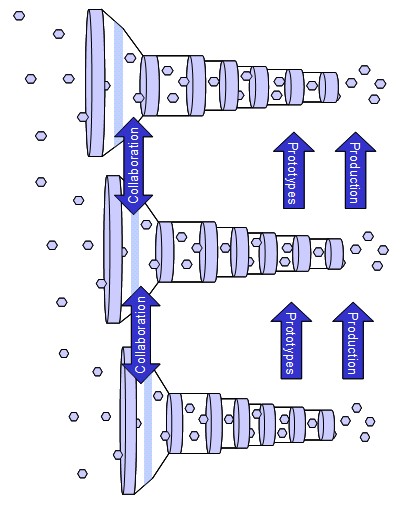
Testing
The validation and testing phase covers the systematic verification of all targets and specifications. Often this phase overlaps extensively with previous phases because early prototype stages will be validated early in the development.
The phase also includes the attainment of relevant approvals from product certification bodies that may vary for different regions.
However, the phase will not exit until every facet of the final market offer has been thoroughly tested, including field testing with customers.
Launch
The launch phase does not begin until the final sign-off of the market offer. It covers the intensive period where the market offer is ramped up to full-scale production or service usage.
Invariably, there are teething problems and the full development team is required for speedy resolution. Also, this phase should include any post-mortems to support organisational learning and continuous improvement of the development processes.
Support
After a successful launch, the bulk of the development team can be redeployed to other projects. A skeleton crew will be required to support the downstream life of the product. Alternatively, there may be a formal handover to a service and/or modification control organisation.
General Innovation
Although stage-gate was originally envisaged for large development investments in new technology products, it is also suited to smaller innovations in any aspect of your business model, leading to increases in the level of innovation undertaken due to improved risk management.
However, it is important that the review process is not over-wieldy for small projects. In fact, for many small projects, the value of stage-gate is in the project planning framework and the process must be adapted appropriately.
The Harvard Business Review [5] identifies the following types of innovation that are not limited to the new product development programme.
- Creating new market space or new points of differentiation
- Supply chain changes, insourcing/outsourcing
- New processes – business or industrial
- New technology, research, and experimentation
- Better information management
- Product architectures
- People, cultural, and resourcing changes
- New strategies or tactics
- Pricing, warranties, guarantees, and service, etc …
- Creative Problem Solving
Nevertheless, it is still important to treat any changes to your business model in the same controlled way that you would undertake product developments. A business is so complicated that it is easy to lose control of any changes unless a scientific approach is taken.
In other words, improvement ideas are proposed and evaluated, business measurements are taken before the change, the winning change ideas are implemented and then measurements taken again after to ensure that the improvement has worked. Therefore, an adapted stage gate framework is ideal for managing the change pipeline with Total Quality tools such as 6-Sigma and Lean [6,7] for prioritisation and problem-solving.
It is helpful to divide your business into two: activities that change the business and activities that run the business. Running the business would be classed as day-to-day operations that operate according to some blueprint or intellectual capital. This blueprint comprises of your business processes, product & service designs, the know-how in your employees’ heads, documented knowledge, and the relationships with your customers and suppliers.
On the other hand, innovation falls into the changing business camp. These changes alter the blueprint in some way that improves the business operations. The changes can be either incremental or breakthrough or a mix of both.
Successful businesses somehow manage to keep their market lead by introducing innovations more effectively than their competitors. They create an Innovation Factory that constantly introduces desirable changes to the business blueprint that improves the “day-to-day” business operations. All this is done in a controlled way that ensures that real improvements happen.
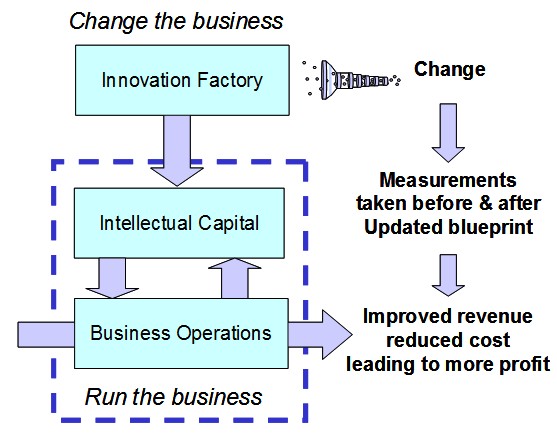
Innovation Performance
Once, your stage gate pipeline has been established it is natural to seek ways to improve it’s performance. The important parameters for stage-gate performance are the funnel entrance, funnel length, funnel exit and the neck diameter.
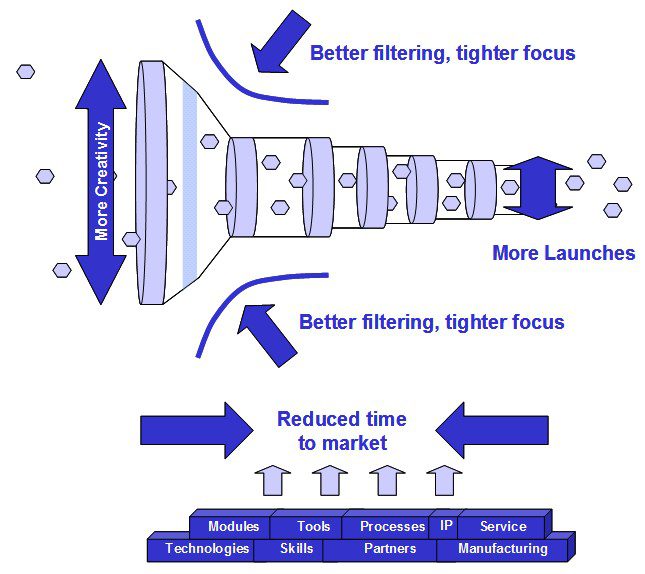
The entrance determines the degree of creativity. How many ideas are actively sought? Remember, ideas are in competition with each other and so more ideas will raise the overall standard. A web-served innovation management system can ease the data collection requirements and also help with the initial screening.
The length determines the time to market. Reusable platforms, modules, existing facilities, and operations will shorten the development time. The role of the technology and product roadmap is to determine which platforms should be developed so as to accelerate all subsequent developments. The roadmap should translate business strategy into the best platform and technology developments. Other accelerators are the calibre of your skills, your tools, risk management competence, etc.
The funnel exit determines how many market launches your organisation is capable of performing. This is not determined by the stage gate process but by the organisation’s capability to handle the launch requirements and to field any issues that might arise. It is wasteful to have a funnel exit broader than this capability because you will be unable to launch the surplus developments. Therefore, the funnel exit should be compatible with your launch capability and the prior filter stages should ensure that only the best development comes through.
The funnel neck determines the level of resources tied up in development and it should be as narrow as possible. This will ensure that ideas are culled sooner rather than later. Your strategy focus, the accuracy of filtering, and the competence of your staff will achieve this aim. However, it is important that ideas are fairly evaluated and only terminated because of a shortcoming or because there is a genuine better opportunity. If the system is not fair then you will undermine the innovation culture and ideas will be less forthcoming in the future.
Invention
Invention and ideas are the raw fodder that feeds this stage-gate engine. It is simply more ideas, more filtering, and hence better quality outputs. However, nothing is more elusive than ideas if the climate is not right or if your staff are not engaged with this process. This is obviously addressed by innovation-oriented leadership that appropriately tackles fear, complacency, politics, unfairness, and other inhibitors.

However, even with the right climate, it can still be a tall order to come up with lots of ideas. Creativity techniques when properly applied can rapidly generate numerous ideas. Most techniques focus on objectives and help identify hidden mindsets that limit the thinking of the inventor [8,9].
For instance figure 6 identifies a box in terms of the objective, solution criteria, your capabilities, and the competitor’s solutions to the problem. Now challenge some of these parameters. Such as, is this the right objective? Why, why, why, why, why are we doing this? This type of interrogation helps you get to root causes and over-arching objectives.
Maybe one of the criteria is that the development cost must be very low. Immediately, your thinking is highly limited by investment constraints which probably would not be true if you really did identify a blockbuster.
Forget the usual competitors, can you imagine a super competitor that would really help raise your standard? Or maybe, you can imagine super capabilities that completely freshen your thinking. Once the new ideas are rolling, you can seek the new capabilities through partnerships or technology breakthroughs.
And so, the trick is to escape from the box and then return after adjusting some of the parameters. Other useful tools that accelerate creativity and evaluation are QFD and TRIZ [10,11]. However, common to all methods is a good understanding of the customer or problem owner and market needs.
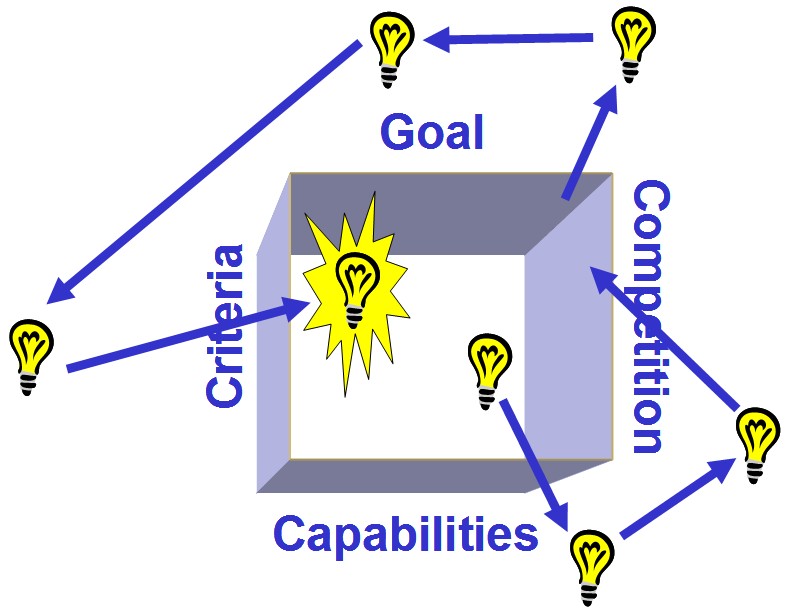
Idea Uniqueness
If you have a good idea that addresses a strong need in an attractive market, then expect other people to copy your idea as soon as the potential is proven. Right from idea inception, you should be taking measures to create barriers that prevent competitors from exploiting your efforts.
Equally, it could be that you have unwittingly copied someone else’s idea. Downstream lawsuits, after you have developed and launched your product could be very costly indeed.
On the other hand, if you did discover at the start that your idea was similar to someone else’s then you have the option of abandoning the development before spending too much money. Better still, you also have the option of improving the idea so that it is original and superior. Profits will depend on some kind of exclusivity.
How to stop people from copying it?
The main tool for protecting your idea during the early stages of development is secrecy. Do not disclose your idea to anyone other than your immediate team unless you are covered by a confidentiality agreement. Even when your product is on the market, keeping your know-how or trade-secrets secret is an important impediment to competitors.
It is easy to keep the software, the contents of computer chips, product models, processes, or even your expertise secret.
However, for some things, the inner workings are immediately apparent as soon as the product is launched and in these cases, the only form of protection is to obtain intellectual property rights to prevent theft.
What are Intellectual Property Rights?
All businesses own intangible assets called intellectual property such as inventions, designs, signs, etc.
Broadly speaking, Intellectual Property Rights (IPR) provide legal protection for original work. Any work that already exists in the public domain by definition cannot be original. Existing work in the public domain is often referred to as “prior art”. For instance, it is possible to invalidate your own invention by public disclosure before filing the patent, hence the need for secrecy.
There are different forms of Intellectual Property each with a different method of protection and differences between countries; therefore the appropriate IP professional should be consulted before making any IP decisions. These forms of IP include:
- Copyright to protect literary, artistic, musical work, and computer software. This is an automatic right with no registration procedures. However, it is wise to develop evidence of the date of origination. It is important to realise that copyright does not protect the idea, but protects a particular phrasing and can be circumvented by for instance rewording the work.
- Design Right and Registered Design to protect the outside appearance of things that include configuration, ornamentation, and shape of a product. Like copyright; design right is automatic, however, a registered design is registered at a patent office.
- Trademarks to protect the signs that distinguish your business from another. These signs can include symbols, logos, words, sounds, or jingles. Trademarks need to be registered at the Patent Office.
- Patents to protect inventions. A patent generally relates to the way that something works and is the broadest form of protection. It can relate to medicine, chemical processes, electronic circuits, or control systems. To be patentable an invention must be novel, not be obvious, and should have industrial application. This last criterion is to discount impractical inventions such as perpetual motion machines.
The right blend of IP protection will very much depend on the nature of your invention. However, whatever the idea, some form of IP protection and search should still be conducted.
Even when you plan to only exploit your idea in a niche market, clearance should be sought by performing an IP search so as to avoid infringement of other people’s IP.
This article provides a uniqueness questionnaire where you can score the strength of your idea by assessing its originality. Check out the Invention Uniqueness Scorer here.
Open Innovation – the Future
Currently, there is a decline in the innovation capabilities of many leading companies, at a time when ideas abound. Many companies are having a bad time maintaining their internal R&D investments.
Why is it that Cisco won the battle for the telecommunication switch market against Lucent? When Lucent had all the might of Bell Labs in its armoury and Cisco had a negligible R&D capability.
Why was it that Xerox researched and developed the computer mouse, the graphical user interface, and many other computer inventions and yet few of them made any money for Xerox’s shareholders?
All over the world research-based companies like DuPont, Merck, IBM, GE, Motorola, Siemens, and AT&T have had a tough time battling it out with non-traditional research-based companies like Nokia, Microsoft, Intel, Sun, Oracle, Cisco, Genentech, Amgen, and Genzyme.
Henry Chesbrough [2] in his book, sees this as a paradigm shift from Closed Innovation to Open Innovation. The paradigm of Closed Innovation argues that successful innovation requires control. Companies must generate their own ideas, develop and assemble them, market and distribute them, and service and finance them.
The logic of closed innovation is based on the following assumptions:
- We should hire the best and brightest so that all the smartest people in our industry work for us.
- If we discover, develop and market our own ideas then we will get to the market first.
- The company that innovates first will win.
- If we lead the industry in R&D investments we will lead the market.
- We should control all our intellectual property so that our competitors cannot profit from our ideas.
At its prime, the logic of Closed Innovation created a fantastic virtuous circle; where increased profits from innovation flowed back into the corporate R&D centres, which in turn strengthened their knowledge monopoly as they scooped up all of the best and brightest and created further breakthroughs.
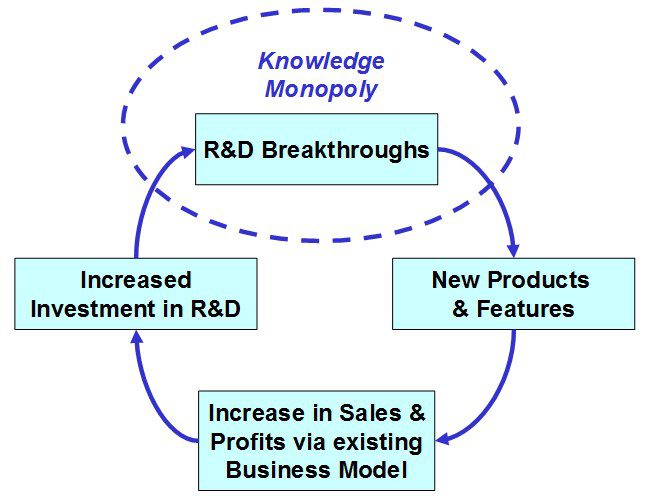
The idea of closed innovation with its central research laboratories was based on the German Chemical industry and Thomas Edison’s school of invention. Ideas go into your stage gate funnel and if they are not killed can only leave at the exit of the funnel.
For most of the twentieth century, this model worked well.
BUT
The world has changed; new factors have eroded the model, such as:
- Greater mobility of highly experienced and skilled people.
- The increased amount of college and post-college training that has allowed knowledge to spill out from corporate silos.
- The growing availability of private venture capital. Often highly specialised and incentivised start-ups make formidable competitors to established firms.
- Faster development times have shortened the advantage and shelf life of any new technology.
- A stage gate project kill due to incompatibility with the host firm’s business model can leave the project team very frustrated (as in Xerox’s case). With so many options available for the project team, there is bound to be greater skill migration.
All these factors make it far less certain that companies will reap the benefits from their research programmes. In fact, their investments may even lead to the development of stronger or new competitors.
Hence, the cycle of the virtuous Closed Innovation circle has been broken and the returns from R&D investments have dwindled.
The Open Innovation model that Chesbrough describes [2] shows the necessity of letting ideas both flow out of the corporation in order to find better avenues for exploitation and flow into the corporation as new offerings and business models.
The root logic of Open Innovation is based on an abundance of knowledge that must be readily used if it is to benefit the company that created it. It cannot be restricted by the internal pathways to the market or else the value will have expired before exploitation. Likewise, other companies and sectors are also madly generating knowledge that could be of quick value to your own market.
This perspective suggests some different organising principles for innovation. In particular, the stage gate funnel now needs adapting so as to accept projects at multiple points in the pipeline and also to license, spin out or sell projects to other companies’ pipelines if the internal route should prove to be too slow or complicated.
The mantra for Open Innovation should now read:
- Not all smart people work for us but we need to tap into their abilities wherever they are.
- External R&D can create significant value, although internal R&D is still necessary to capture this value.
- Building a better business model is better than getting to the market first – look at Google!
- If we make the best use of internal and external ideas, we will win!
- We should profit from our own ideas even if we do not take them to our own markets.
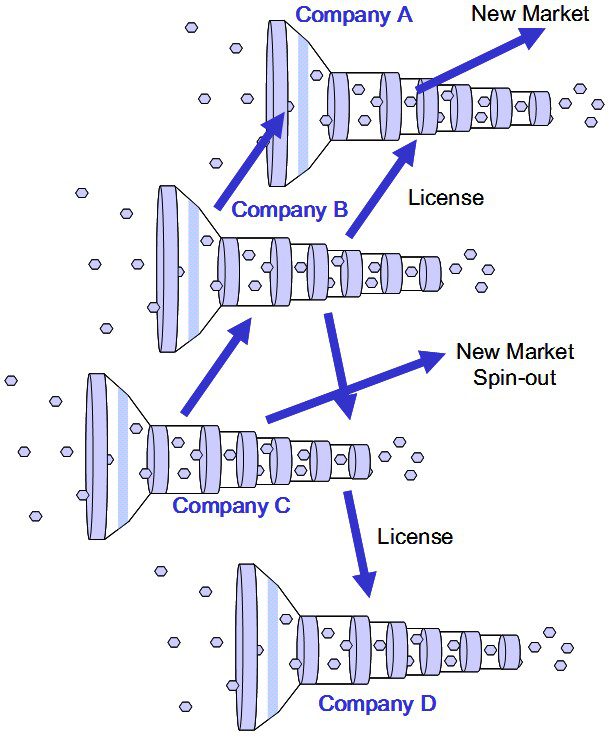
Some industries have always adopted an Open Innovation approach such as the film industry and construction. Others such as Procter and Gamble have taken the plunge and adopted Open Innovation with breathtaking commitment with their Connect and Develop initiative.
Other industries have not seen the same erosion factors such as nuclear, aerospace, and defence. And it would probably be folly to precipitate such a move; however, they should still be observant of the signs.
Some industries are at the start of the transition, such as Automotive; and it may even be yours. If your market is moving faster, you feel that you are no longer getting the returns from your R&D investments and they are ballooning, you are experiencing a high turnover of research and development staff, …..
… then possibly, just possibly you should move towards Open Innovation.
Conclusion
Innovation is the act of invention and implementation through market exploitation.
Beyond innovation is a disruptive innovation that fundamentally changes our social practices or the way we live, examples are the telephone, the automobile, television, and the internet. The best approach and outcome for disruptive innovation are always likely to be highly uncertain and unpredictable.
However, we should never stop innovating or disrupting or else we stagnate and ultimately become subsumed by other people’s innovations. Innovation is likely to remain difficult but essential for long-term survival.
Hopefully, this guide has helped affirm some familiar techniques and introduced you to some new models for innovation. When ideas stop or become stale, the time is right to start innovating your innovation process – give it a kick-start, form an innovation factory or do something radical now!
References
[1] NESTA: The National Endowment for Science, Technology and the Arts, www.nesta.org.uk
[2] Open Innovation: The New Imperative for Creating and Profiting from Technology by Henry Chesbrough, Harvard Business School Press, April 2003
[3] Winning at New Products by Robert G. Cooper, Addison Wesley 1993
[4] Setting the PACE in Product Development by Michael E. McGrath, Butterworth Heinemann, 1996
[5] Harvard Business Review on Innovation, Harvard Business School Press 2001
[6] Lean Six Sigma: Combining Six Sigma Quality with Lean Speed by Michael L. George, McGraw-Hill 2002
[7] Lean Thinking: Banish Waste and Create Wealth in your Corporation by James P. Womack and Daniel T. Jones
[8] 101 Creative Problem Solving Techniques: The Handbook of New Ideas for Business by James M. Higgins, New Management Publishing 1994
[9] Imagination Engineering: A Toolkit for Business Creativity by Paul Birch & Brian Clegg, Pearson Education 1996
[10] Quality Functional Deployment: Integrating Customer Requirements into Product Design. Translated by Glenn Mazur. Cambridge MA: Productivity Press 1990
[11] The Innovation Algorithm: TRIZ, Systematic Innovation and Technical Creativity by G. Altshuller, Technical Innovation Center 2002
[12] Esp@cenet, Europe’s network of patent databases on the web: http://www.espacenet.com, European Patent Office
[13] United States Patent and Trademark Office, http://www.uspto.gov
[14] New Product Innovation – How to Outsmart the Competition, Raglan Tribe, 2023
Remember to look out for open innovation!

